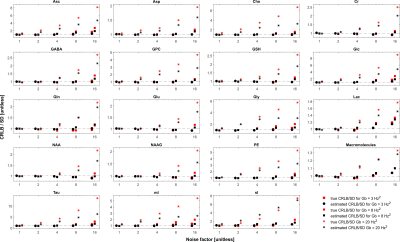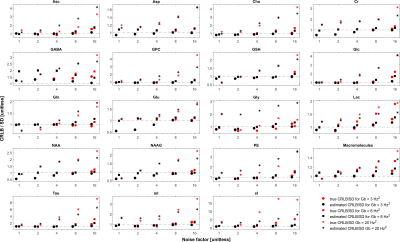Karl Landheer1 and Christoph Juchem1,2
1Biomedical Engineering, Columbia University, New York City, NY, United States, 2Radiology, Columbia University, New York City, NY, United States
1Biomedical Engineering, Columbia University, New York City, NY, United States, 2Radiology, Columbia University, New York City, NY, United States
Cramér-Rao Lower Bounds
have
become the routine method to approximate standard deviations for MRS. It was
shown that this is an appropriate approximation when the model characterizes
the data, but not when the model deviates from the data.

Figure 4: The true CRLBs
(red) and estimated CRLBs (black) divided by the standard deviations calculated
through MC simulations for the estimated amplitudes for the 18 metabolites and the
macromolecules signal across 5 different noise factors (NF = 1 to 16) in the
case where the model properly characterizes the data. The circles, squares and
stars represent Gb = 3 Hz2, 8 Hz2, and 20 Hz2,
respectively. The breakdown SNR is reached when the true CRLB divided by
standard deviation (red) is greater than 1. Similar results were obtained for
the other four estimated parameters.

Figure 5: The true CRLBs
(red) and estimated CRLBs (black) divided by the standard deviations calculated
through MC simulations for the estimated amplitudes for the 18 metabolites and the
macromolecules signal across 5 different noise factors (NF 1 to 16) in the case
where the model does not properly characterize the data. The circles, squares
and stars represent Gb = 3 Hz2, 8 Hz2, and 20 Hz2,
respectively. The breakdown SNR is reached when the true CRLB/SD (red) is consistently greater than 1. Similar results were
obtained for the other four estimated parameters.
